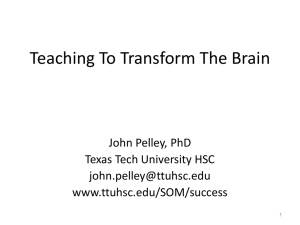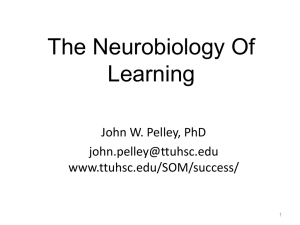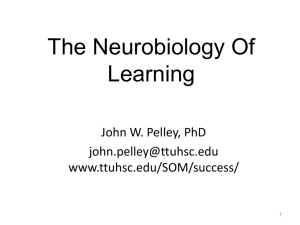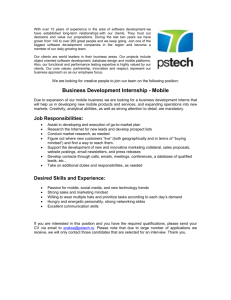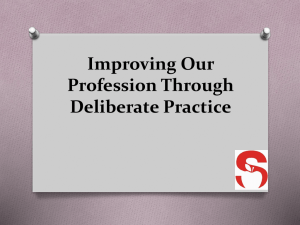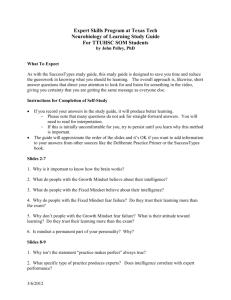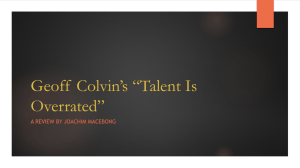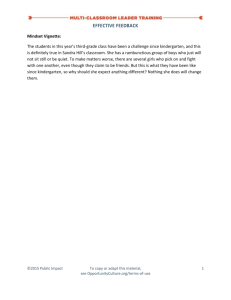SuccessTypes* for Medical Students A Program for Improving
advertisement
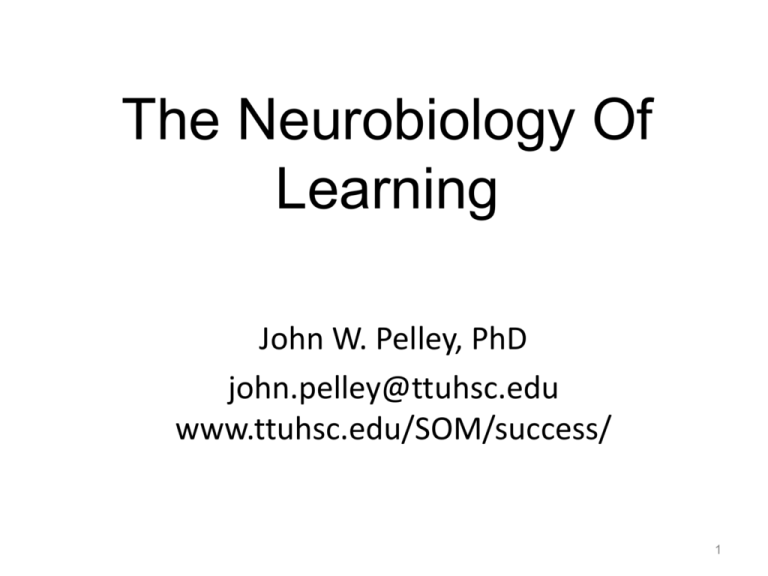
The Neurobiology Of Learning John W. Pelley, PhD john.pelley@ttuhsc.edu www.ttuhsc.edu/SOM/success/ 1 If you don’t know where you are going, any path will take you there “The purpose of an educational institution is to lead the students, who initially believe the educational institution is there to educate them, to the realization that they must educate themselves.” “They must …learn how to learn [integratively]…” From Willis Hurst, MD, Medscape [and Pelley] 3 Main Points Today 1. Students need to transform themselves from receiver role to producer role. – – Receiving information vs producing knowledge Transformation not demanded, but taught 2. Deliberate practice produces expert learning skills. – – Responsibility for learning lies with student. Growth Mindset requires Deliberate Practice. 3. The brain is wired to predispose thinking/learning “styles.” – – Learning style is an insight for Deliberate Practice Growth Mindset requires knowing how the brain 4 works. Your Thalamus Distributes My Biochemistry Lectures To Your Cerebral Hemispheres Thalamus volume setting is high or low (gain control) 5 Prefrontal Pause (1 minute) Getting In Touch With Your Thalamus • Thalamus – base of brain – distributes all sensory information to higher centers – Thinking requires both input and memory Talk with a neighbor about how you do your best thinking: – Talk it out first or, – Think it through first 6 Low Gain vs. High Gain • Talk it out – “low gain” thalamic activity; seeking more input; more active – Extraversion; low arousal level – too quiet – Lower cerebral blood flow, augmentation of “evoked response,” lower doses of sedatives • Think it through – “high gain” thalamic activity; reducing input; more reclusive – Introversion; high arousal level – too loud – Higher cerebral blood flow, reduction of “evoked response,” higher doses of sedatives 7 Why is it important to know how the brain works? Answer: It affects “Mindset” – and mindset affects performance Mindset: The New Psychology of Success, Dweck, C., 2006 8 Prefrontal Pause Turn to a neighbor and answer – (1 min) When do you feel smart? • When you are learning – Studying for a test Or, • When you are flawless – Making a perfect score on a test 9 Growth vs Fixed Mindset Growth mindset – “When you are learning.” • “You can always change how intelligent you are.” Fixed Mindset – “When you are flawless in performance.” • “You have a certain amount of intelligence and you can’t change it.” 10 Mindset Comparison Fixed Mindset • Success based on innate ability • Failure is dreaded, feared. • Least likely to succeed Growth Mindset • Success based on hard work and learning • Failure is a challenge to adapt. • Most likely to succeed 11 Growth Mindset Through Deliberate Practice • Designed specifically to improve performance – Myth: “Practice makes perfect.” – Reality: “Perfect practice makes perfect.” – Reality: “Deliberate practice is perfect practice.” • Deliberate Practice: Practice correcting weaknesses. – Deliberate practice requires self-awareness … and self-acceptance. • Need to avoid automated behavior – Loss of focus and attention, esp. while reading (K. Anders Erickson, “Deliberate Practice and the Acquisition and Maintenance of Expert Performance in Medicine and Related Domains.” Academic Medicine, 2004;79:October Suppl.70-S81.) 12 Deliberate Practice Characteristics • Applied to limitation in skill • Can be repeated a lot – Feedback continuously available – Most effective with experienced teacher • Not work, not play – focused effort; demanding – Need to avoid automated behavior – Not much fun; motivation critical • Highly demanding mentally; tiring • Not aimed at minimum standards – Self-actualization is the standard • 10 years, 10,000 hours – Gladwell, “Outliers” 13 At-Risk Syndrome – The Need For Expert Skills • • • • • Up until 2 am, reading and re-reading Harder study = harder reading Study effort test performance Knew more than others who did better Test questions are tricky 14 Myers-Briggs Personality Types And Learning Style • Preferences Influence how you learn. • Produces self awareness – Critical first step in Deliberate Practice • Affects academic performance • Also affects: – Communication skills – Choice of specialty 15 16 Myers-Briggs Personality Type – What It Is • Mental Model; many others also useful • Normal differences between people • Persistent tendencies (choices) – Do not change once established – e.g. Folding your arms, throwing a ball, writing your name • Comfort zone for thinking; requires less effort than the opposite – Use of opposite is a conscious effort 17 Myers-Briggs Personality Type – What It Isn’t • • • • • Not a measure of intelligence Not a “limitation” No negative aspects No psychopathology No stereotype 18 What Do Those Letters Mean? • Four dimensions of preferences Extraversion (E) vs. Introversion (I)* Sensing (S) vs. Intuition (N)* Thinking (T)* vs. Feeling (F) Judging (J) vs. Perceiving (P)* *Pelley’s type 19 Prefrontal Pause • Talk for a minute with your neighbor about what your preference might be: – Think better with “facts and specifics” – Think better with “big picture and connections” • Try to give an example 20 Sensing (S) vs. Intuition (N) • What information do you give the most attention to? • Sensing types give their attention to specifics • Intuitive types give their attention to the big picture • Everyone does both, but only one is preferred. – Use of opposite is deliberate; not automatic 21 Test Taking Style • N style – First, seek answer that matches poorly memorized knowledge – Rule out answer choices – Don’t fit pattern – Big picture learning establishes patterns • S style – Seek answer that matches memorized knowledge – Re-read question to stimulate recall – Memorization learning requires recognition 22 Memorization vs. HOTS • Memorization – Recall: remembering facts/details and their “organization” (list the symptoms of heart attack) – Preferred by sensing types • Higher Order Thinking Skills (HOTS) – Grouping: “organizing” facts into patterns – Comparing: relationships between patterns (list the causes of chest pain) – Preferred by intuitive types 23 24 Thinking (T) vs. Feeling (F) • How do you react to new information? • Thinking types consider the logical implications. • Feeling types consider the impact on people. • Everyone does both, but only one is preferred. – Use of opposite is deliberate; not automatic 25 Judging (J) vs. Perceiving (P) • How do you manage your life? • Judging types prefer to be planned, organized (joy of closure). • Perceiving types prefer to be flexible, adaptive (joy of discovery). • Everyone does both, but only one is preferred. – Use of opposite is deliberate; not automatic 26 How Do Preferences Relate To Learning? • Extraversion: Good at initiating – think out loud and then think alone • Introversion: Good at reacting – think alone and then think out loud • Sensing: Enjoy using what already learned – bring details but neglect relationships • Intuition: Enjoy learning new things – bring patterns and relationships but missing some details How Do Preferences Relate To Learning? • Thinking: Learn best when given a clear and objective rationale – give and receive objective criticism • Feeling: Learn best when given personal encouragement – bring harmony; sensitive in communication • Judging: Value orderly use of information – complete tasks at expense of new information • Perceiving: Value inquiry and discovery – postpone tasks to acquire more information Developing Expert Skills – Transforming The Brain • How do we change our brains? • Learning efficiency: What is the “illusion of memory?” • What does brain anatomy tell us about how we learn? • Clinical skill areas of the brain 29 How Do I Develop My Brain? • Dendritic Growth – Concept mapping physically changes the brain. • Experiential Learning Cycle – There are minimal criteria for achieving dendritic growth. • Prevent Incomplete Processing – Concept mapping and question analysis (group study) prevent “short circuits.” 30 Can You Find The Sittin’ And Readin’ Dendritic Tree? Sittin’ and readin’ 1. Complete learning cycle 2. Sleep (5 REM cycles) Control left, long-term potentiated (LTP) cells sensitized right Tree of LTP markedly increased (hippocampus “rehearsal”). Dendritic trees are “processing power.” Prefrontal dendritic growth increases analytic skill. 31 Phosphorylation And The Illusion Of Memory • Forgetting Can Be A Good Thing – Neurologic protection: no cluttering with irrelevant information. • The brain is designed to forget. – Phosphorylation decay is the mechanism. – Protein synthesis from decision/action is the override. 32 The Illusion of Memory • New information → temporary phosphorylation at neuron synapse (“illusion of memory”) • Two things can happen: 1. No decision/action → decay of the signal → neuron “forgets” 33 Molecules and Memory Information unused (no decision) cAMP is recycled PKA is inactivated Phosphorylation stops Memory gone NEJM (2006) 355:25 34 Consolidation of Memory • New information → phosphorylation at neuron synapse (“illusion of memory”) • Two things can happen: 2. Use of the information for decision/action → sustained signal → gene activation → synthesis of new proteins → consolidation; neuron “remembers” • Rehearsal by hippocampus during sleep (5 REM cycles, 7.5 hrs, minimum) 35 Gene Expression and Memory e.g. glutamate receptors in the hippocampus (new memory) NEJM (2006) 355:25 36 Experiential Learning Cycle Achieving Long Term Potentiation Outside Can it be used? [Act] Concrete experience Testing implications of concepts in new situations (Kol b, 1 984, p.2 1) Experience new information [Sense] Observations and reflections What is it? [Recognize] What does it mean? [Integrate] Formation of abstract concepts and generalizations Inside 37 Experiential Learning By The Brain Some Motor Skills Thinking Skills Sensory Skills Memory Skills Adapted from Zull, 2002, The Art of Changing the Brain 38 Receiving Information vs. Production Of Knowledge 1. Concrete experience; sensory cortex organizes information 2. Reflective observation; temporal cortex recognizes information 3. Abstract conceptualization; pre-frontal cortex evaluates and decides 4. Active testing; motor cortex acts on information – produces knowledge from the outcome. 39 Prefrontal Pause • How is recognition different from recall? • Related question: What area of the brain is responsible for each? 40 Back To The Future • Temporal (back) processing – Facts, grouping, memorized patterns – From lectures, books, other resources – Information resource for prefrontal decision making • Pre-Frontal (future) processing – “Discovered” patterns, inferences, evaluation of options – Dialog requires a decision based on a rationale, Broca’s area is integrative – ALWAYS BE MAKING A DECISION! 41 What’s Your Favorite Lobe? • What information do you give the most attention to? • Sensing types; Temporal emphasized – Primarily sensory experience – Specifics, routine procedure • Intuitive types; Pre-frontal emphasized – Primarily predictive experience – The big picture, relationships, predictions 42 Neurobiological Effects of Concept Mapping • First, a look at concept mapping • Neurobiology of learning with concept maps • Deliberate Practice and concept maps 43 Anatomy Of A Concept Map • Key terms enclosed in “bubbles” • Fact = two connected bubbles • Connections can contain verbs – describes concept relationship • Branch points represent groupings and organization • Cross-links are comparisons and cause-andeffect; integrative thinking 44 45 Overview of Mapping List – Group – Compare 1. List important terms 2. Group by major topic 3. Compare by drawing cross-links All three steps require use of Deliberate Practice in reading 46 47 Concept Mapping and DP • One of the following will be harder to do than the others • Focus and attention (sensory/temporal/prefrontal) • Identifying the grouping terms (prefrontal/temporal) • Identifying subtopics (prefrontal/temporal) • Organizing relationships at each level of complexity (prefrontal/temporal) • Drawing the map (prefrontal/motor) 48 49 DP Outcomes From Concept Mapping • Slow at first as most-limiting brain function undergoes development – Limiting function is identified and practiced • Faster processing during consolidation of skill areas – Capacity to make decisions faster – Capacity to access long term memory faster • Capacity to retain fact (declarative) memory increased • Transfer of skill to other problem solving venues 50 More About Maps • Remember that maps are living documents; they grow as you learn • Maps don’t have to include everything • Maps are the best study notes • Maps allow you to compare your thinking – …and improve it! 51 Question analysis • Each answer choice is studied in depth to establish conditions that rule out or accept • Understanding the correct answer. – Minimum knowledge to rule-in the correct answer • Understanding the wrong answers. – Minimum knowledge to rule-out the wrong answers – Rephrasing the question • Check SuccessTypes book at website 52 Question Analysis: “Ruling-Out” Thinking • Questions – ultimate learning objectives – Shows how are topics tested – Shows how you have to think • Understanding a question – Many do not test memorization, but organization and integration. • Teachers believe that they have addressed each “wrong” answer – Called rational alternatives – Each answer is correct for a different question. 53 Problem Solving Essentials – Summary Thoughts • Team contribution is critical – Learning “types” develop the non-preferred function faster when they hear it (experience!) – Develop “inter”-dependence • Mental functions are skills, not intelligence! • Mental functions are developed through Deliberate Practice. 54 Recap • Experiential learning “flows” through the cortex – Always completed through action – Personality type reflects time allocation. • Experiential learning develops both: 1. Cognitive memory 2. Critical thinking skills • Long-term memory is external evidence of dendritic tree growth (temporal cortex). • Critical thinking (analytic) skill is external evidence of dendritic tree growth (prefrontal cortex). 55
